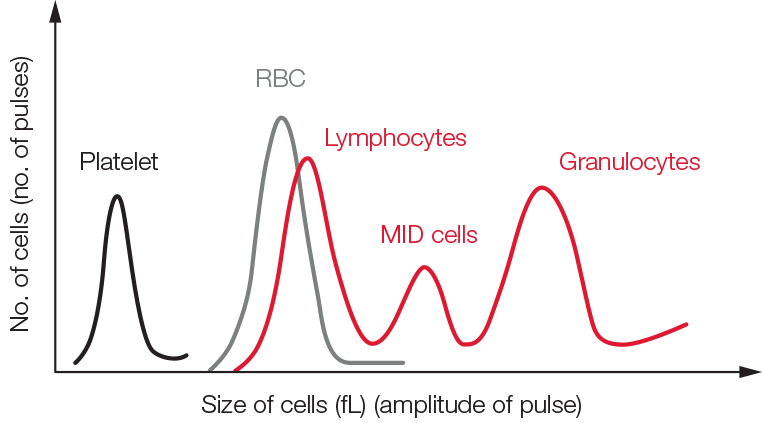3-part versus 5-part hematology systems for complete blood count

A complete blood count (CBC) is typically the first test requested by a physician to evaluate a patient’s general health status. For such screenings, automated hematology analyzes are frequently used. In addition to determine blood levels of platelets (PLT), red blood cells (RBC), and white blood cells (WBC), most analyzer can also differentiate WBCs into 3 (LYM, MID, GRAN) or 5 (LYM, MONO, NEU, EOS, BASO) subpopulations. Although a so called 3-part hematology analyzer provides sufficient information for most clinical settings, trends show an increased interest in 5-part instruments. While 5-part analyzers can offer more detailed information on the white blood cells, 3-part instruments can offer great cost benefits.
Clinical settings where 3-part differentials and 5-part differential can provide different advantages
Although each WCB type provides information that helps diagnose blood-related conditions, a 3-part instrument will provide sufficient information for the typical physician office laboratory (POL). With a simple CBC, the neutrophil and lymphocyte counts will answer the question of a viral infection or a bacterial infection that can be treated with antibiotics (Fig 1).

For specialty laboratories, however, a 5-part instrument can provide a more detailed and targeted assessment of the blood status. To distinguish eosinophils and basophils from neutrophils, for example, a 5-part differentiation is mandatory (Fig 2).

However, the cost for a typical 5-part instrument can be two to three times higher (20,000 to 50,000 USD) than for a 3-part instrument (less than 10,000 USD). In addition, a 5-part differential often requires more reagents than a 3-partdifferential, also increasing the cost per test from below 1 USD/test for a 3-part differential to 1.5 to 3 USD/test for a 5-part differential. Yet, government reimbursements commonly do not consider whether WBCs are differentiated into 3- or 5-parts. Hence, 5-part instruments are typically used by oncology or allergy clinics that can justify the need for eosinophil and basophil counts.
Depending on local policies, samples that are flagged as abnormal commonly require microscopical examination to confirm the results obtained with the analyzer, regardless of instrument type. For this, blood smears are typically sent to a hematology laboratory for a manual count. According to many hematology laboratories experienced in blood smear examinations, the number of samples that requires manual examination can be greatly reduced with the more detailed information on the blood status provided by a 5-part differential. If about 30% of the total number of samples generates a suspicious flag with a 3-part instrument, and thus will require manual examination, the more detailed information provided by a 5-part instrument can reduce this number to about 20%, ultimately decreasing laboratory time and cost for shipping of samples.
For general screenings, however, and when reimbursement is the same irrespective of 3-part and 5-part differential, a 3-part instrument can contribute to an improved laboratory economy by offering the caregiver a greater profit opportunity. In addition, a 3-part instrument based on robust impedance technology might require less maintenance than a 5-part instrument, which also includes a more sensitive laser-based measurement technology.
Learn more
Read more about the differences and similarities of 3-part or 5-part hematology analyzers from this whitepapper.